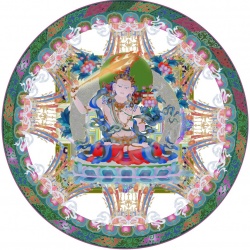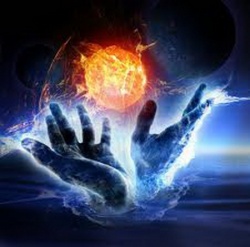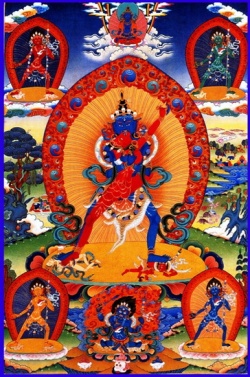Buddhism and Self
Sandra LaFave
West Valley College
The Buddhist scripture "The Questions of King Milinda" contains interesting and very modern arguments about personal identity through time. In effect, Buddhism rejects the key element in folk psychology: the idea of a self (a unified personal identity that is
continuous through time).
King Milinda and Nagasena (the Buddhist sage) discuss ordinary problems of personal identity. Nagasena says: "As Nagasena I am known, great King ... But ... this word 'Nagasena' is just a denomination, a designation, a conceptual term, a current appellation, a mere
name. For no real person can here be apprehended."
At first Milinda is astonished. Milinda thinks persons obviously exist: "This Nagasena tells me that he is not a real person! How can I be expected to agree with that!" But Milinda gradually realizes that "Nagasena" (the word) does not stand for anything he can point
to: "Nagasena" does not designate the hairs on Nagasena's head, nor the hairs of the body, nor the "nails, teeth, skin, muscles, sinews, bones, marrow, kidneys, ..." etc. In other words, the term "Nagasena" has no obvious denotation. Milinda notes that the term
"Nagasena" also does not stand for Nagasena's form, or feeling or perceptions, impulses, or consciousness, nor any combination thereof. On the other hand, "Nagasena" does not stand for anything other than ("outside the combination") Nagasena's form, feelings, etc.
Milinda concludes that "Nagasena" doesn't stand for anything, and this is puzzling.
Nagasena answers with one of several arguments by analogy. The analogy is of the chariot. Nagasena points out that we can't say exactly what a chariot is, either; it's not the pole or the axle or the wheels, or the flag-staff, yoke, reins, etc. But that doesn't mean
there are no chariots. Milinda realizes that "it is in dependence on the pole, the axle, the wheels, the framework, the flag-staff, etc., that there takes place this denomination 'chariot' ..." Nagasena concludes: "It is just so with me. In dependence on [the parts]
there takes place this denomination 'Nagasena.' ... In ultimate reality, however, this person cannot be apprehended."
The discussion continues. If we can't say what a person is, then how do we know a person is the same person through time? Nagasena's answer is basically that the question is badly formed, since you can give equally good reductio ad absurdum arguments that we are the
same through time and that we are not the same.
WHY YOU'RE THE SAME
To prove: You are the same person.
Suppose you are different, in the sense that you now are not the same person as before.
Then you'd have no past -- no mother, no father. You do have a past, however, so it is absurd to suppose you are different.
To prove: You are the same person.
Suppose you are a different person in the sense that you are completely different at every moment.
Then you'd have many mothers, fathers, etc. This is absurd, QED.
WHY YOU'RE NOT THE SAME
To prove: You are a different person.
Suppose you are the same person. Then you'd still be a child, a baby, etc., which is absurd, QED.
THEREFORE YOU ARE NEITHER THE SAME NOR DIFFERENT.
If you can't say what the person is to begin with, and furthermore, you can't say whether a person is the same throughout a single life, then how can you say the same person is reincarnated in another body? What could reincarnation possibly mean?
Milinda asks: "When someone is reborn, is he the same or different?" Nagasena answers, "Neither." What's wrong here is our initial understanding of what it means to be anything in a world governed by dharma. The truth, says Nagasena, is that I'm not the infant or the
grown-up but instead both comprise "one unit depending on ["in dependence on"] this very body." The relation of dependency is the key (just as in the chariot analogy).
Nagasena explains the dependency relation using two other similes:
1. The lamp and the flame. The flame is never the same flame from moment to moment, though the lamp remains the same. Consciousness is the flame. The lamp is cosmic dharma. "Dharma" is from the Sanskrit word for "hold," "bear," support," or "sustain." Dharma is
the law that holds the world together. One principle of dharma is the law of karma: the world is held together by the law of dependent origination (things come to be depending on how things were, and there is no difference between causal and moral dependence). Another
principle of dharma is the unity of all sentient beings.
2. Milk / curds / butter / ghee. Milk becomes curds, which become butter, which becomes ghee. Milk is not the same as curds, butter, or ghee, but it's also not different. Those things are because of it, according to the laws of the universe. Something persists, in
the sense that later things would not be as they are if earlier things had been different. It's misleading to say any nameable thing persists through all the changes, but nameable things in the past do really continue to influence things in the future.
Thus whatever constitutes "me" is not something I can name or point to, but what I am continues to affect what I become from one incarnation to the next. What I am now continues in the sense that it continues toaffect the unfolding of the universe according to dharma.
BUT WHAT IS CONTINUOUS?
Milinda asks, "Is there any being that passes from one body to the next?"
Nagasena answers this without paradox: "No!" We just established that there is the universe and it is held together by the dharmas, which govern all change (dependent origination) of things within the universe. That's all there is. Change is the constant; "things" are
not. So the question is not well-formed.
You are "you" only because you are still attached to things, and not "pure." You think of yourself (you are conscious of yourself) as someone who is separate (has the illusion of real difference and independence from the rest of the universe). You as this fictional
separate being have desires: you think you want things or states of affairs to be different from the way they are. This constitutes being attached. As long as you remain attached, you remain discontented, under the illusion of separateness, and you remain part of the
circle of change (samsara). But when we say "you" remain attached and continue through the cycle of samsara, we don'tmean that there's some personal soul with particular traits that "goes" from one body to another. It just means that what comes later is
causally/morally connected to earlier stuff according to the laws of karma.
WHY SHOULD I ABANDON ATTACHMENT, THEN, if I'm not going to be the same person who'll pay for it in my future incarnation?
That's not the point. If you're still attached, you're paying right now. Your craving now IS your suffering. Give it up and you have Nirvana now. The trick is to stop wishing you were off the wheel, stop wishing, period. You must realize that your true being is
nothing, and has no desires at all.
There's really no you, and if there's no you, there are no beliefs or desires for you to have, since according to folk psychology, beliefs and desires have metaphysically subjective being (like pains, they exist only as experienced).
The folk psychology picture is profoundly misleading and believing it will make you miserable.



